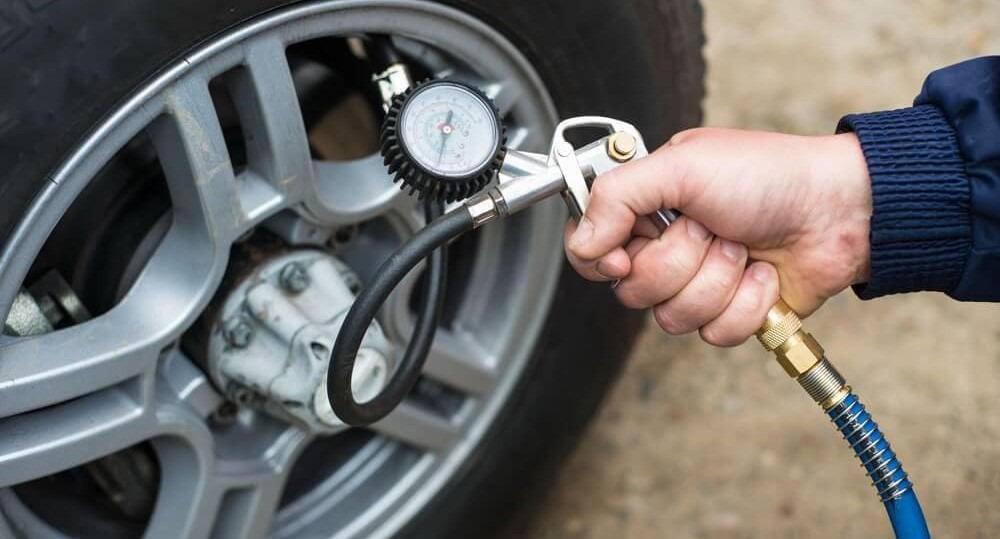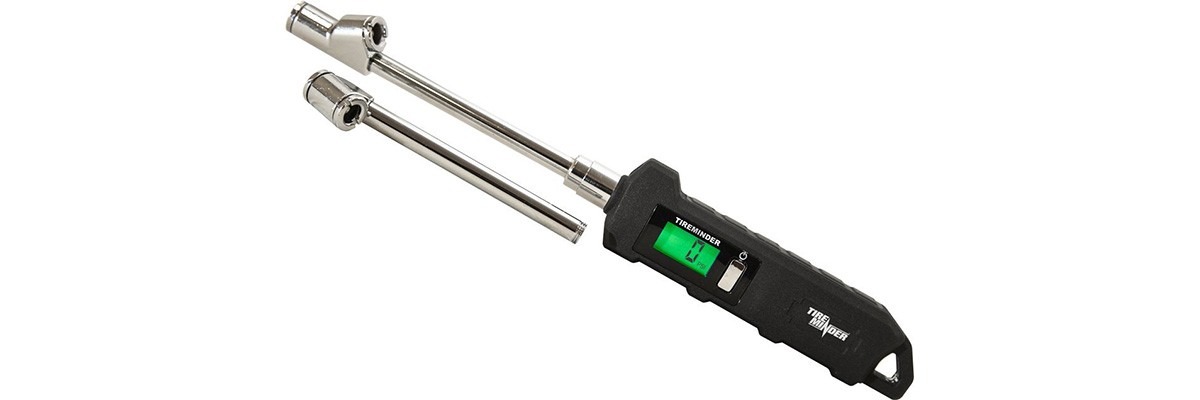
To feel secure on the road, make sure the best tire pressure gauge is at hand. Checking the tires fast can prevent the incident and save you fuel and replacement of the worn-out tires.
Modern pressure gauges differ by type, size, connection chucks, operational range, and additional features. Still, the most important factor is the accuracy of the measurement.
While many producers state their gauges are next to 100% precision, testing them on the same tire can show up quite different indications. Testing the gauge, consider the consistency as well. Fixing 30 PSI on the unchanged tire is better than having multiple indications of 29.3 PSI, 30.1 PSI, and so on.
Accuracy also depends on the gauge type. Usually, the digital pressure checkers have a more detailed measurement, while the analog ones have a good consistency.
The chucks used in the pressure gauges determine the user’s comfort and quickness of connecting the gauge. The faster it is sealed on the tire stem, the less air is let out of the tire.
The pressure gauge can feature additional features like various measurement units, integrated light, air compressor connection, and so on.
Read on and find your best tire pressure gauge!
Tire Pressure Gauges Reviews
Best Tire Gauges for Cars
AstroAI ATG150

High accuracy and comfort of use let this pressure checker claim the title of the best tire gauge for cars. It registers the pressure in the range from zero level up to 150 PSI, which is more than enough for most city cars and light trucks. The producer states the accuracy is quite high – up to 0.1 increment, letting check the slightest change in the tire condition. That’s particularly important in the changing climate with temperature shifts.
The pressure gauge is versatile, showing the pressure equally precise in Bar, KiloPascal, and Kgf per sq. cm units. Thus, the pressure checker is easy to use on the tires by different producers and different pressure marking. The tool is equipped with the developed nozzle design, fitting the Schrader stems well and getting sealed to them quickly. The only con is that for the ideal connection the gauge must be placed at an angle, so the LCD screen might be not visible directly.
The screen is wide enough and the digits are well visible. It’s backlit brightly as well as the nozzle allowing use the pressure checker in the poorly lit places and at night. The tool is very lightweight and features the ergonomic wave-shaped handle with the place for each finger, fully deserving its top positions in the tire pressure gauge reviews.
Pros
- Can operate at a moderate cold and extreme heat without issues.
- 30-seconds automatic shut-off is enough for checking the pressure and saving the battery.
- Very compact, fits most car glove compartments.
Cons
- Doesn’t form a sealed connection with presta stems.
- Needs two types of batteries for operation.
TireMinder TMG-AAA

This long-shaped pressure checker is one of the sturdiest tire pressure gauges. It has all-metal construction and weighs a full pound. The metal heads are made of high-quality material, get on without effort, and fit seamlessly. There are two heads supplied with the gauge, for direct and angled connection to the stem.
The pressure gauge is the digital type showing consistent measurements with about 0,5-1 PSI difference. This matches the producer’s data on the accuracy of this unit (mistake range within 1 PSI). While the gauge doesn’t register the empty or next-to-flat tire, it provides accurate data starting from 10 PSI and up to 150 PSI. It can be used for a variety of vehicles and household appliances, helping control the city car, RV, baby stroller, and air mattress.
The gauge is equipped with the standard LCD screen, backlit for operating in the dark. There is the flashlight integrated to illuminate the stem and let control the connection in the poor visibility.
The pressure checker has a non-slipping design and is comfortable to hold and use. The activation button is located on the top part and is big enough to control. The fingers embrace the gauge for a firm grip; yet, the LCD screen isn’t concealed.
Pros
- It measures the pressure in PSI, bars, and kPa.
- Implements the most common batteries type (two AAA units).
- The handy pouch is good for storing and quickly taking out the pressure gauge.
Cons
- It needs a few seconds connection to start checking.
- The button is too sensitive and might activate the gauge if touched by other objects.
Accutire MS-4021R

This small and lightweight pressure checker for cars is a good solution for drivers looking for the most accurate tire pressure gauge. Its readings are consistent with a tiny deviation within 0.05 PSI (with the pound increment of 0.5).
The unit has a rugged construction with all components fitting well. The massive chuck gets sealed to the valve stem easily with a bit of pressure. The reading appears on the LCD display upon pressing the button on the back part of the gauge.
The screen is large comparing to the size of the gauge itself and is well visible even in the dusk due to backlight. It’s located on the side of the tool, so the user should bend over in order to read all the data.
The pressure gauge features the automatic shut-off system for preventing tire deflation and battery draining. This unit is furnished with the internal Lithium-Ion battery and three coin cell ones, the latter being replaceable. The LCD screen signals once the internal battery is low.
The gauge has an unusual shape and is easy to use on stems at different positions. It has a convenient resting place for a thumb finger and a rubber non-slipping handle.
Pros
- Up to 150 PSI serving for a different type of cars.
- Good price-to-value proportion.
- Four spare valve caps supplied.
Cons
- Too short idling period before shut-off.
- The measurement units are small and not well discernible on the screen.
Longacre 53006

Handy design, the versatility of operation, and accurate reading make this car pressure checker the good choice among professional car tire pressure gauges. Despite the small range of the registered pressure, it provides the immediate reading. The gauge can fix the lowest pressure starting from the zero mark and up to 60 PSI, which fits most of the modern cars.
Though it is marked as a basic model, the accuracy and consistency of this model are quite high. The deviation range makes 0.2 PSI that isn’t relevant for most routine applications of the pressure gauge. This accurate tire pressure gauge is highly sensitive registering even the slightest pressure changes when deflating some air at the gauge removal or inflating the tire.
Unlike other gauges on the list, this model doesn’t require the button hold to operate — it constantly reads the pressure while it’s on. It is equipped with the flexible hose letting connect the nozzle to the stem even in the tight places. The ball and angle chucks supplied allow connecting the gauge easily and form a reliable non-leaking connection.
The gauge has a heavy-duty construction, with the metal connecting parts, thick (14’’) rubber hose and the protection bumper for the main part of the tool.
Pros
- Real time reading serves well for using the gauge with the air compressor.
- The deflating button lets bleed the air if needed.
- Simple and easy-to-use interface.
Cons
- The LCD display is quite dim.
- The display doesn’t save the readings once it’s off the tire.
Best Tire Gauges for Motorcycles
TireTek TT-GS06-QBR2

This professional motorcycle tire pressure gauge has the complete set of features required by the bikers. Its strong build, proved preciseness of readings, easy-to-follow dial, and lifetime producer warranty are those qualities every driver should be aware of.
The pressure checker reads the inflation level within the range of 0 to 60 PSI, which covers all types of motorcycles, most cars, and RV vehicles. It has the certified accuracy level (Grade B) by the international standard allowing no more than 2% deviation from the actual pressure condition.
The gauge is of mechanical type with an analog dial. The arrow indicates the registered pressure immediately, saving the reading on the display; thus, sparing the time for memorizing and rechecking the pressure.
The pressure gauge has all-metal working parts assembled seamlessly. The dial has thick rubber protection shaped as a tractor wheel, which is drop-proof. The stem and the chuck are made of high-quality steel. The ball chuck swivels for 360 degrees establishing a reliable no-leaking connection with the tire stem. Priced at least a half of the price of the digital models, this unit could claim the title of the best motorcycle tire pressure gauge, wouldn’t the readings occasionally skip at the air release.
Pros
- Developed chuck design forms a sealed connection even when not fully pressed down on the stem.
- Side-mounted air release valve helps deflate the tire without removing the gauge.
- Small size and weight, handy to hold and operate.
Cons
- The gauge reads the pressure in PSI only (no other units maintained).
- No intermediate markings (e.g. 5, 15, 25 PSI).
Ionox ION-15S

This top rated tire pressure gauge for motorcycles has several features making it a reliable and handy pressure meter. It is quite small and lightweight fitting into any hand and has a simple and intuitive interface.
The nozzle and the LCD screen are backlit with the bright blue light letting use the checker in day and night time. The handle has rubberized pads for better grip of the gauge, with the activation button in the center.
The gauge reads the pressure condition in four measurement units: KPa, kg per sq. cm, PSI, Bar. It memorizes the last reading made and displays it at the next activation. The meter can register the pressure ranging from 0.5 PSI to 150 PSI covering all types of motorcycles tires and many car ones. It features a high level of tire pressure gauge accuracy and consistency, showing the correct readings even for under-inflated tires. Used on the same tire, it provides steady results differing at about 0.2 PSI.
Pros
- Immediate reading upon pressing the activation button.
- Shuts off upon 30 seconds of idling saving the battery charge.
- Die-cast grainy metal case promises durability and long-lasting use.
Cons
- No reading reset function.
- The air leaks quickly if the nozzle is placed incorrectly.
TireTek TT-GH01-QBR2IC

This professional tire pressure gauge is designed for controlling the pressure in motorcycle tires particularly. It’s quick and easy in operation, doesn’t depend on a power bank and works in various weather and climate conditions.
The gauge is based on the mechanic principle and features the analog dial with the precise needle indication. The display is quite big and well-readable with clear markings.
The gauge is very sensitive fixing the pressure levels exactly even at extreme points (0 and 60 PSI). It tracks the slightest change of the inflation level of the motorcycle tires while showing high consistency on the unchanged tire readings. The air release valve on the side lets deflate the tire while checking its condition in real time.
This good tire pressure gauge has a solid build. The working parts are metal, and the connections are easy to screw on. However, the chucks do not fit the presta valves.
Pros
- Straight and angled chucks let connect the gauge to any tire valve.
- Heavy-duty yet flexible hose lets connect and check the hard-to-reach tire stems.
- 3/8’’ hose connections prevent air leakage and ensure precise operation.
Cons
- Straight chuck gasket often gets blown off at the gauge removal.
- The air release valve is rather slow.
Buyer’s Guide
How does a Tire Pressure Gauge Work? A Brief Overview
The pressure meters differ by type and the actual technology used. However, the general principle of work is the same. The gauge body consists of the air receptacle and calibrating rod. When the meter is connected to the tire valve, the air starts filling the receptacle and activating the rod, which, in turn, shifts the needle in the analog gauges or produces electric signals (in the digital ones).
There are two types of analog gauges:
- Bourdon tube. Incoming air straightens the curved tube that activates the needle on display.
- Bellows. The airfills and expands the bellows inside the gauge; this movement is registered on display.
Digital pressure meters also come in two types:
- Strain. Contains the diaphragm responding to the pressure and forming the electric impulse, which is then transformed into the reading.
- Piezoelectric. Integrate quartz sensors getting the strain from the air and producing the electric signal.
How to Use Tire Pressure Gauge on a Car?
Though the pressure gauges are quite simple in their construction and usage, there are certain rules to adhere to get the precise reading.
- Tires must be cold. Spinning motion and friction causes the tire to warm up, and the air inside gets expanded. That’s why, for correct pressure reading, it is recommended to use the gauge on the entire cold tires, some three hours after driving.
- Check the climate. In cold weather, the pressure inside the tire can read about 10% less than its actual condition. It will expand upon warming up the air during motion.
- Check the car. Optimal pressure indicated on the car label serves for the non-loaded car. Increasing the load means adding more pressure to the tires.
- Check the road. On some terrains like sand, gravel, etc. the optimal pressure for safe driving is less than the one stated on car label.
- Calibrate the gauge. Before using the new pressure meter, compare its readings on the same tire with the well-known reliable checkers (e.g. an old trusted tool or a professional gauge at the gas station). Verify the readings several times, in similar periods (let’s say, in 5, 10 and 15 minutes), since the consistency factor is highly important for the accurate gauge reading.
- Connect the gauge to the tire valve. Most car tires are equipped with the schrader valves pairing well with the pressure meter chucks. Still, some motorcycle and bicycle tires might feature presta valves that need a special tip to form a sealed connection. Make sure the connection is firm and the air doesn’t escape.
- Activate the gauge by pressing a dedicated button or read the reading on the instant-on / analog gauges. Wait for the final measurement, when the needle no longer moves (in analog gauges) or the digits stop changing (in digital models).
- If needed, refill the tire by means of an air compressor (if connected) or deflate it through the air release valve, usually present in most gauges.
- Upon finishing the pressure check, quickly remove the gauge chuck to avoid air loss.
How to Check Tire Pressure without a Gauge? Tips
If the gauge isn’t at hand, but you need to check the pressure in order to get to the nearest service station, you can use the following methods:
- Feel the tire. Squeeze the tire or try it with your foot. The stiffer and less responsive the tire is, the more pressure it has.
- Make the puddle test. Drive into the puddle or soak the tire with water. Then direct the car on a dry road. The wet track will show how much the tire is in contact with the road.

My name is Brandon, and I’ve been interested in cars since I was a kid. I got a bachelor’s degree in Automotive Technology and worked in a private car workshop. I have two cars that have been completely upgraded with my own hands. So I successfully put all my knowledge into practice.
Last update on 2025-12-17 / Affiliate links / Images from Amazon Product Advertising API



